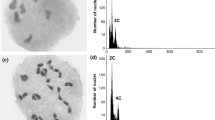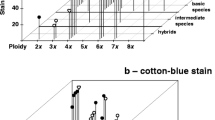Abstract
The analytic-synthetic scheme makes use of haploidization and 2n gametes-mediated sexual polyploidization to incorporate genetic diversity from wild related species in potato breeding. Whereas 2n pollen can be directly screened by microscopy, 2n eggs are routinely screened indirectly by interploid crosses, a time-consuming and inaccurate technique. In five haploid tbr × wild diploid species families with variability for agronomic characters, 2n eggs were screened indirectly to incorporate this germplasm into a useful form and directly by microscopy to establish the feasibility of this approach. For the indirect screening, at least 15 flowers of each of 49 genotypes/family were crossed with a commercial cultivar. Eighty-five fruits were produced; only 15 of them had seeds (1–25). Chromosome numbers were determined in a random sample of five seeds/fruit, resulting diploid in two genotypic combinations and tetraploid in another two. For the direct screening, eight combinations of staining and destaining (times and concentrations) were evaluated in detached ovules to adjust a clarification technique. The best combination was one day of staining and one day of destaining in 0.5 % acetic acid. In an indirectly detected diplogynoid, the average diameters of the central cell nuclei (CCN) and nucleoli (CCNu) were, respectively, 9.3 μ and 3.4 μ. Gametophytes with diametres 1.26 times the average were considered 2n. By crosses, eleven seeds were obtained in one fruit of this clone whereas the 2n egg frequency determined by microscopy was 7%. The direct technique is easy to carry out once the eye is trained and its results better reflect actual 2n gamete frequencies.
Similar content being viewed by others
Notes
Endosperm Balance Number: hypothetical genetic factors provided by the female and male parents that have to be, respectively, in a 2:1 relation in the endosperm for normal development of this tissue (Johnston et al. 1980)
References
Camadro EL, Peloquin SJ (1981) Cross-incompatibility between two sympatric polyploidy Solanum species. Theor Appl Genet 60:65–70
Coleman LC (1938) Preparation of leucobasic fuchsin for use in the Feulgen reaction. Stain Technol 13:123–124
De Jong H, Tai GCC (1977) Analysis of 4x—2x hybrids in cultivated potatoes. Potato Res 20:111–121
Dione LA (1958) 2, 4-Dichlorophenoxyacetic acid as an aid to seed production when widely separated Solanum species. Nature 181:361
Grun P, Aubertin M (1966) The inheritance and expression of unilateral incompatibility in Solanum. Heredity 21:131–138
Hanneman RE Jr (1989) Potato germplasm resources. Am Potato J 66:655–668
Hawkes JG (1990) The potato. Evolution, biodiversity and genetic resources. Belhaven Press, London
Hawkes JG, Hjerting JP (1969) The potatoes of Argentina, Brazil, Paraguay and Uruguay. A biosystematics study. Oxford University Press, London
Jansky SH, Peloquin SJ (2006) Advantage of wild diploid Solanum species over cultivated diploid relatives in potato breeding programs. Gen Resources and Crop Evolut 53:669–674
Johnston SA, Den Nijs TPM, Peloquin SJ, Hanneman RE (1980) The significance of the genetic balance to endosperm development in interspecific crosses. Theor Appl Genet 56:5–9
Johnston SA, Hanneman RE (1980) Support of the Endosperm Balance Number hypothesis utilizing some tuber-bearing Solanum species. Am. Potato J 57:7–14
Leue EF , Peloquin SJ (1980) Selection for 2n gametes and tuberization in Solanum chacoense. Am. Potato J 57:189–195
Marks GE (1966) The origin and significance of intraspecific polyploidy: experimental evidence from Solanum chacoense. Evolution 20:552–557
Masuelli RW, Camadro EL (1997) Crossability relationships among wild potato species with different ploidies and Endosperm Balance Numbers (EBN). Euphytica 94(2):227–235
Mendiburu AO, Peloquin SJ, Mok DWS (1974) Potato breeding with haploids and 2n gametes. In: Kasha KJ (ed) Haploids in higher plants. Guelph Univ Press, Guelph, Ontario
Quinn AA, Mok DWS, Peloquin SJ (1974) Distribution and significance of diplandroids among the bdiploid Solanum. Am. Potato J 51:16–21
Ross H (1986) Potato breeding-problems and perspectives supplement. Verlaug Paul Parey, Berlin and Hamburg
Santini M, Camadro EL, Marcellan ON, Erazzú LE (2000) Agronomic characterization of diploid hybrid families derived from crosses between haploids of the common potato and three wild argentinian tuber-bearing species. Am J Potato Res 77:211–218
Stelly DM, Peloquin SJ (1985) Screening for 2n female gametophytes, female fertility, and 2x × 4x crossability in potatoes (Solanum spp). Am Pot J 62:519–529
Stelly DM, Peloquin SJ, Palmer RG, Crane CF (1984) Mayer’s hemalum-metyl salicylate: a stain technique for observations within whole ovules. Stain Technology 59(3):155–161
Author information
Authors and Affiliations
Corresponding author
Rights and permissions
About this article
Cite this article
Erazzú, L.E., Camadro, E.L. Direct and indirect detection of 2n eggs in hybrid diploid families derived from haploid tbr × wild species crosses. Euphytica 155, 57–62 (2007). https://doi.org/10.1007/s10681-006-9300-7
Received:
Accepted:
Published:
Issue Date:
DOI: https://doi.org/10.1007/s10681-006-9300-7




